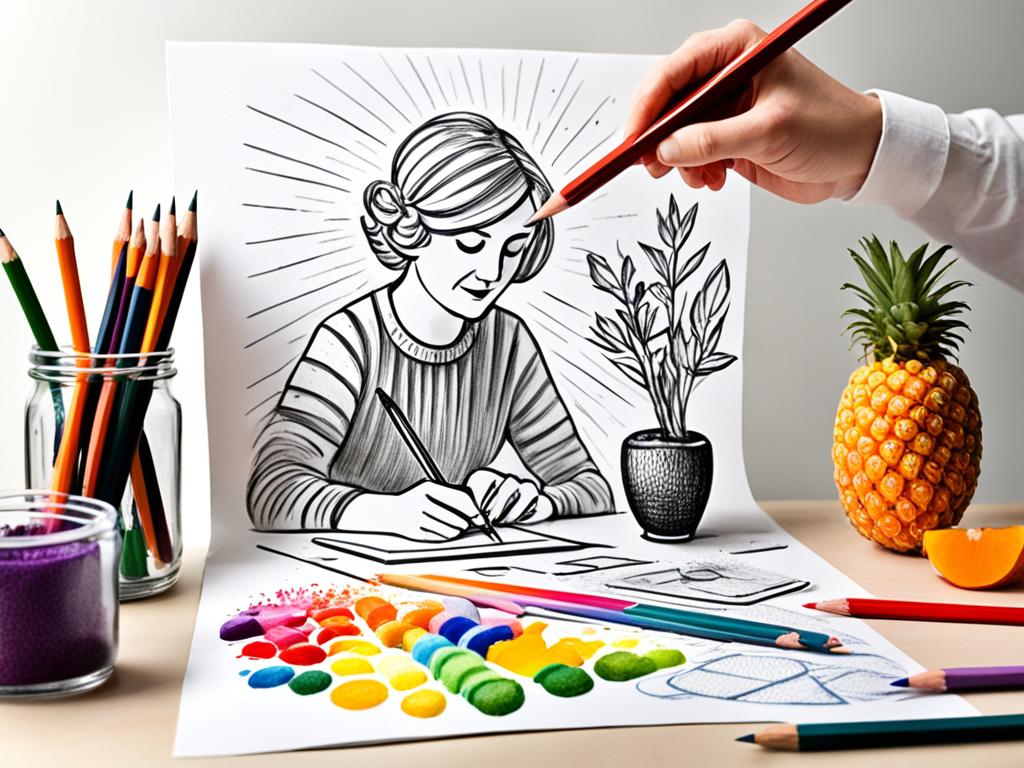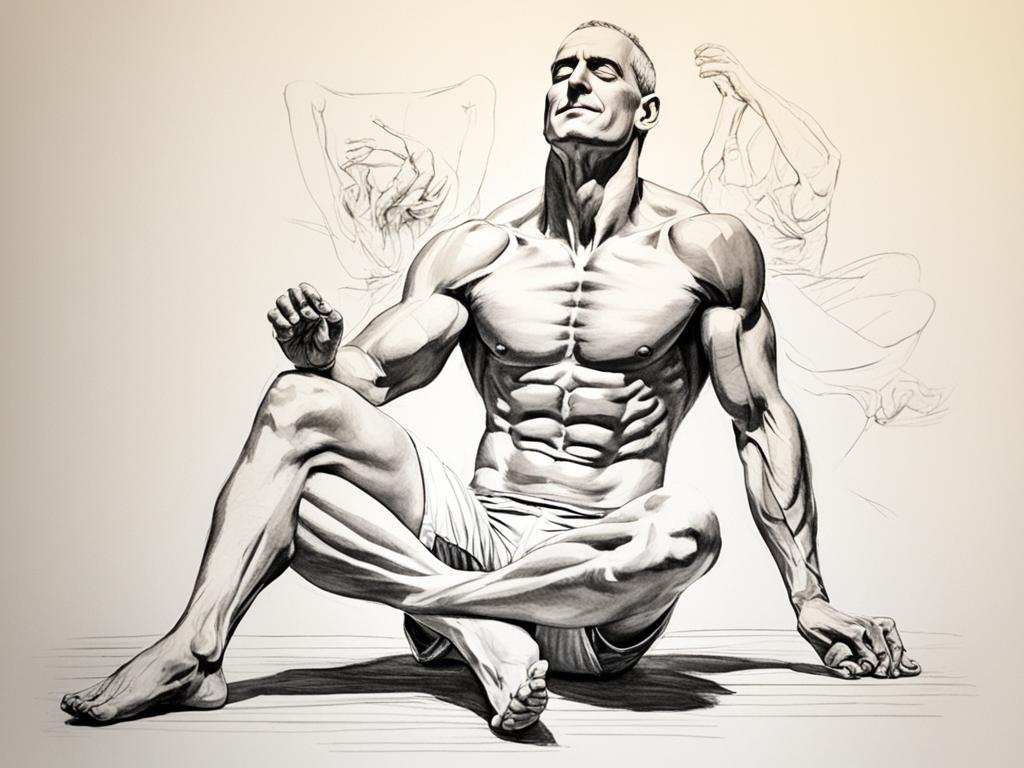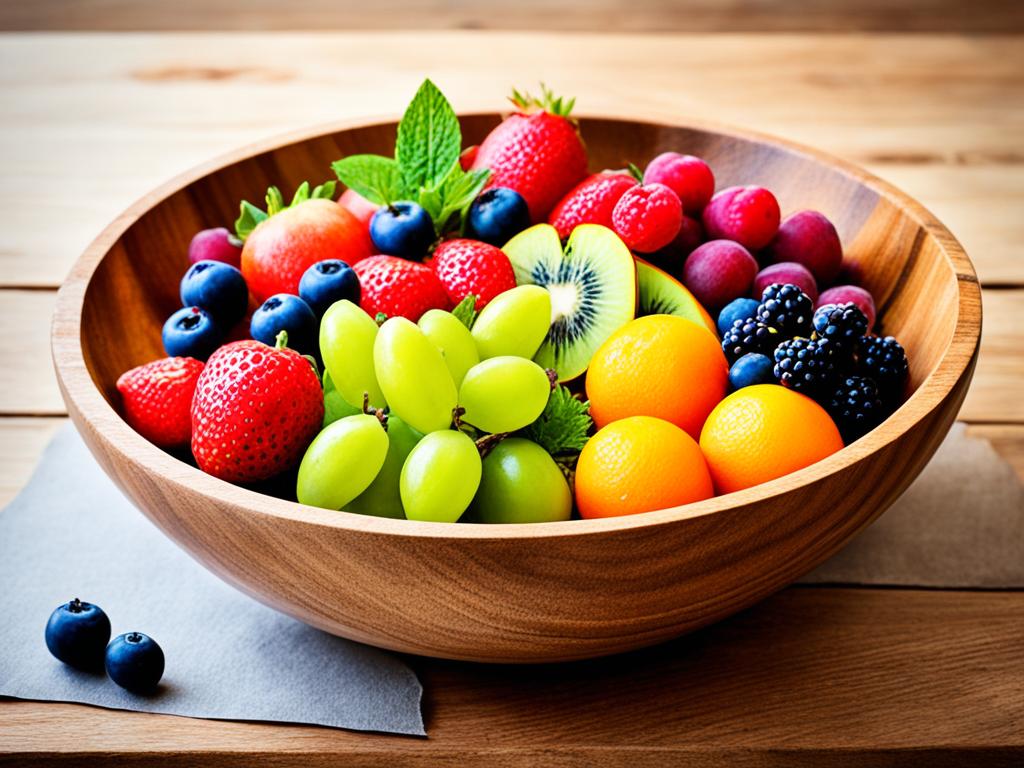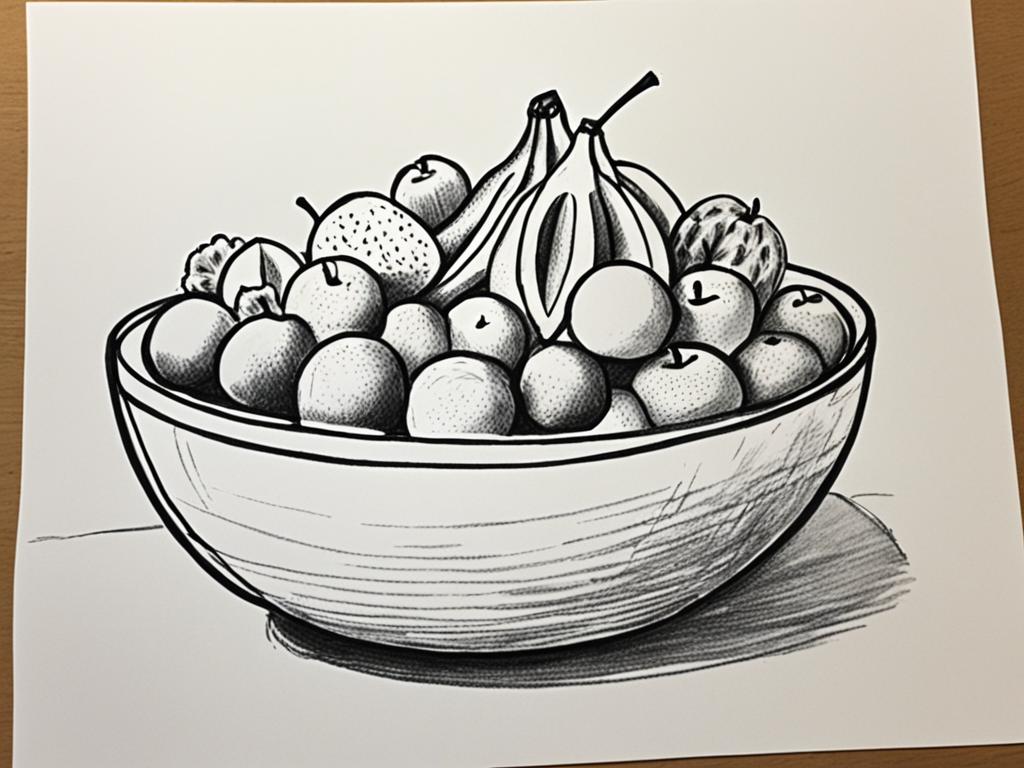Ever think about the difference between a great artist and a good one? is it just talent or hard work? Both matter, but the key is practice sketching.
Practice sketching is how you get better at art. It means drawing a lot to learn new things and get better at techniques. But why is all this drawing so important?
Sketching Techniques for Beginners
If you’re just starting with sketching, it might feel a little overwhelming but very exciting too. The key is to learn the right methods. These will help you turn what you imagine into real drawings.
First, we’ll look at some important sketching methods. These will create a good base for your drawing journey. With regular practice of these skills, you’ll soon make really great sketches.
Basic Strokes
Being good at basic strokes is important in sketching. You need these strokes to draw all kinds of shapes and lines. It could be a face or even something from nature. Knowing how to use your pencil well will make you a better artist.
“The beauty of sketching lies in simplicity. Mastering basic strokes allows you to express your ideas and feelings with just a few lines.” – [Artist Name]
Try out different stroke types, like hatching, cross-hatching, and stippling. This will make your sketches look more real and interesting. Change the way you use your pencil to show details and effects in your artwork.
Shading Techniques
Learning how to shade brings your sketches to life. It makes them look three-dimensional and real. When you understand how light works, your drawings will look more like what you see in real life.
One shading method is ‘gradation.’ It means moving smoothly from dark to light areas. This makes your drawings look natural. By practicing gradation and noticing how light hits objects, your skills will get better.

Understanding Proportions
Getting the right proportions is crucial. It means drawing things in the right size and shape. This makes your sketches look accurate and catch the eye.
Study human body proportions and those of other things you want to draw. Notice how different parts relate to each other. This basic knowledge is important for making more advanced sketches later on.
Practice Regularly
To get better at sketching, just keep practicing. Make sketching a part of your weekly routine. The more you do it, the easier and better you will get.
Sketching is mainly about being creative and showing who you are. Enjoy the journey and don’t worry about being perfect. As you try different techniques, you’ll find the ones that suit you best.
| Sketching Techniques for Beginners | Benefits |
|---|---|
| Mastering basic strokes | Build a solid foundation for drawing various shapes and lines. |
| Shading techniques | Add depth, form, and realism to your sketches. |
| Understanding proportions | Create realistic and visually appealing representations of your subjects. |
| Regular practice | Improve your skills and develop your own unique artistic style. |
Equipped with these essential techniques, you’re ready to start drawing confidently. Keep practicing, and try new stroke and shading methods. As you keep at it, you’ll see your artwork improve and come alive in ways you didn’t expect.
Mastering Perspective Drawing
Many artists find perspective drawing hard at first. But with the right method, it can be very useful. It lets you show depth and space in your drawings, making them look real. This is essential for sketching landscapes, buildings, or any scenes. It makes your art more detailed and lifelike.
To draw well in perspective, you must learn the basics. Here are tips and exercises to start with:
1. Learn the Basic Principles
Start by understanding the foundations. Learn about vanishing points, horizon lines, and foreshortening. These are crucial for creating accurate drawings.
2. Use Proper Measurements
Getting the measurements right is essential. Focus on the sizes and distances between objects. Use perspective grids to keep things in the right proportion.
3. Practice With Still Life
Begin with drawing simple still life setups. Place objects at different heights and places to create depth. Notice how things become smaller as they move further away. Use this in your drawings.
4. Experiment With Different Viewpoints
Try drawing from not just eye level. Drawing from above or below can bring new life to your art. It introduces new challenges and makes your work more dynamic.
Improving in perspective drawing requires practice. Spend time working on it regularly. Making mistakes is part of learning. Enjoy the process, and you’ll soon create drawings that look real and capture attention.
Capturing Lifelike Figures in Your Sketches
Drawing the human figure is a wished-for skill for many artists. By creating lifelike figures, your art can show real emotion. Although it seems hard at first, improving is possible with time and effort. You can accurately draw the human body’s beauty and details. Let’s look at some techniques and tools to make your figure sketches better.
Anatomy: The Foundation of Figure Drawing
Understanding the human body’s anatomy is key to drawing accurate and believable figures. Spend time learning about body parts like the head, arms, and legs. Get to know the bones and muscles. Drawing from books, real life, or digital aids can make your figures look real.
Gesture Drawing: Capturing Movement and Flow
Gesture drawing captures a figure’s movement and energy quickly. It makes you see the pose’s rhythm. Begin with loose lines to show gesture and movement. Don’t worry about details yet; just get the pose’s feeling right. This approach improves your skill in drawing dynamic figures.

Value and Shading: Adding Depth and Dimension
Adding value and shading is important in figure drawing for depth and realism. Notice light and shadow on the figure. Use techniques like hatching for different tones. Learning how light works on the body makes drawings more lifelike. Watch light and shadow on various body parts. Try different shading to make your figures look three-dimensional.
Resources and References for Figure Drawing
Using resources and references is very helpful for figure drawing. Try life drawing classes or online sources. They provide poses and angles to practice. Also, look at famous artists’ works to learn and get inspired for your drawings.
By using these tips and tools, you can draw lifelike figures. Always remember, mastering figure drawing takes time and practice. Enjoy the journey, get feedback, and keep challenging yourself to get better.
Still Life Sketches: Bringing Inanimate Objects to Life
Still life sketches are a great way to get better at seeing and drawing what’s around you. They help you understand shapes, textures, and how things fit together. We’ll show you how to make your sketches look real by focusing on details.

Observing the Subtle Details
When you draw still life objects, really look at them. See how light and dark make them interesting. Take in the textures and what makes each one special. This helps you show the uniqueness of every item in your sketches.
Arranging Your Composition
How you place objects in your drawing matters a lot. Try moving them around to find the best look. Use composition rules like the rule of thirds to make your sketch guide the eyes smoothly.
“Still life sketches allow us to pause and appreciate the beauty in everyday objects. They challenge us to capture their essence and bring them to life on paper.” – Maria Johnson, Professional Artist
Playing with Colors and Contrast
Using color and contrast can make your sketches pop. Mix warm and cool colors to create depth. Add shades and highlights for a 3D effect. Colors can set the mood and highlight important parts of your sketch.
Adding a Personal Touch
Even though still life is about real things, you can still make it your own. Try out different ways to draw, like lines and angles. This is how you make your drawings stand out.
Tools and Techniques
There are many ways to draw still life. You can use pencils, pens, or charcoal. Try different strokes and blends to show textures. This makes your drawings interesting and detailed.
To get better, keep drawing and looking at stuff. Practice regularly with things around you. This is how you’ll get good and make drawings that really seem alive.
The Art of Observational Drawing
Observational drawing is a key part of the art world. It means looking closely at the world and drawing what you see. By doing this, you learn to show the small details that make your drawings real.
It helps you see shapes, forms, textures, and colors better. No matter what you draw, you notice all the little things. It’s a way to really look at your subject and put what you see on paper.
“Observational drawing teaches us to see and understand the world in a unique way. It’s about slowing down, taking in our surroundings, and capturing what we see with precision and artistry.”
Here are some tips to get better at observational drawing:
Spend Time in Nature:
Go outside with your sketchbook and enjoy nature’s beauty. Whether in a park or a forest, nature is full of things to draw. Watch the light and shadow, the details in plants, and how animals move. Drawing nature helps you show the world better.
Focus on Still Life:
Make your own still life scene with objects you like. Think about how they look together. Notice the light on them. Drawing these scenes helps you learn about shape, volume, and texture.
Explore Urban Sketching:
Urban sketching is about drawing city life scenes. Go to your local area or a busy city to find things to draw. It could be the buildings, people, or a market’s energy. This lets you record the liveliness of a city.
Join Life Drawing Classes:
Life drawing classes let you draw from real models. This helps you understand anatomy, size, and how things move. Drawing real life makes you look closer and understand better.
Observational drawing gets better with time and practice. Don’t worry about making mistakes. Each drawing helps you see things more like an artist.
| Benefits of Observational Drawing | Techniques to Enhance Observational Drawing Skills |
|---|---|
| – Develops keen observation skills – Enhances hand-eye coordination – Encourages mindfulness and focus – Improves visual memory |
– Start with simple objects and gradually add complexity – Use different drawing tools and materials – Experiment with various perspectives and viewpoints – Practice capturing textures and details |
| Essential Supplies for Observational Drawing | Tips for Drawing from Life |
| – Sketchbook – Variety of pencils and pens – Erasers – Drawing board or easel – Lighting source |
– Begin with quick gestural sketches – Observe and analyze your subject before starting – Break down your subject into basic shapes – Pay attention to light and shadow |
Expressive Gestural Sketching
Gesture sketching is an exciting way for artists to catch a subject’s essence and motion. It focuses on energy, emotion, and spontaneity. We will look at various techniques and exercises to grow your skills.
Techniques for Gestural Sketching
For gestural sketching, ditch the need for control. Let your lines flow freely. Here are several techniques:
- Quick strokes: Use quick, energetic lines to grab the subject’s form and movement.
- Loose lines: Use expressive and loose lines to show movement and life in your sketches.
- Gesture drawing: Start with simple lines to capture the subject’s movement. Then, add detail while keeping the sketch lively.
- Exaggeration: Feel free to exaggerate parts of the subject. It helps make your sketch dynamic and alive.
- Varying pressure: Play with the pressure of your pencil. This creates different line weights and adds depth.
Gestural sketching is about the energy a subject gives off. Be brave and trust your gut. With practice, you’ll find your unique gestural style.
Exercises for Gestural Sketching
Specific exercises can make you better at gestural sketching. Try these to improve your skills:
- Sketching from observation: Watch moving things and sketch them quickly to capture their motion.
- Gesture drawing sessions: Join sessions or use online tools with timed poses. This helps you learn to draw quickly and expressively.
- Blind contour drawing: Draw without looking at your paper. This focuses you on the subject’s movement and shape.
- Continuous line drawing: Draw without picking your pencil off the paper. This promotes a fluid and spontaneous style.
Using these techniques and exercises will improve your gestural sketching. Remember, it’s about capturing the energy and movement, not perfect details.
| Gestural Sketching Tips | Benefits |
|---|---|
| Embrace spontaneity and freedom | Expresses the energy and movement of the subject |
| Use quick strokes and loose lines | Conveys a sense of dynamism and vitality |
| Practice gesture drawing regularly | Refines your ability to capture the essence of a pose |
| Don’t be afraid to exaggerate | Creates expressive and impactful sketches |
| Experiment with varying pressure | Adds depth and dimension to your sketches |
Conclusion
Practicing sketching is key to better art skills. Spend time often to draw. This will improve your art and make your sketches vibrant.
In this article, we looked at many ways to better your drawing. We learned about perspective and drawing people in a lively way. Each part shared tips to make you a better artist.
Keep exploring and learning as an artist. Practice drawing a lot. Doing this, you’ll find your special way of creating art that’s all your own.
Get started with a pencil and sketchbook. Your journey into art and self-expression begins. Let your creativity guide you. Happy sketching!




